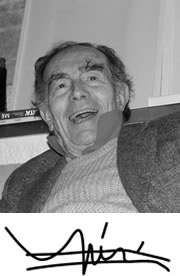Vico Magistretti
Milan, 1920
In his own words, Magistretti intended to create essential objects, similar to nothing that has been done before, taking as a starting point a concept that would help him to set free from any problems with style. A main characteristic of his projects was the full integration of technique innovations without stressing them, that is why he achieved that customers accepted naturally his articles. Magistretti is well known for having been the first Italian designer in producing plastic furniture. His work was internationally acknowledged, and he was awarded all throughout his career with many...
In his own words, Magistretti intended to create essential objects, similar to nothing that has been done before, taking as a starting point a concept that would help him to set free from any problems with style. A main characteristic of his projects was the full integration of technique innovations without stressing them, that is why he achieved that customers accepted naturally his articles. Magistretti is well known for having been the first Italian designer in producing plastic furniture. His work was internationally acknowledged, and he was awarded all throughout his career with many awards, such as a golden medal and a Grand Prix in the Milan Triennial exhibitions, two Compasso d Oro, and one golden medal of the Society of Industrial Artists and Designers (SIAD), among others.Magistretti is part of the generation that followed the so-called "maestri del moderno", a group of architects that led the BBPR studio in the 30s: Banti, Belgiojoso, Peresutti, and Rogers. Rogers, specifically, was a great defender of the Modern Movement and thus had huge influence on the new Italian designers at the time. In fact, Magistretti traveled to Lausanne in order to attend a course on architecture and urban design led by Rogers.Born in 1920 in Milan, Magistretti studied architecture and spent some time in the Champ Universitaire Italien in Lausanne. He then came back to Milan, where he graduated, and started working at his father s studio, after what he set up his own studio. His first designing projects are from those years, they consisted of a tubular shelf and an office chair for the Riunione Italiana exhibition at the Mostre di Arredamento (RIMA).Throughout the 50s, Magistretti focused his career on architecture, showing his avant-garde style. Some of his projects were for example an office block in the Corso Europa in Milan, or in the design of the Villa Arosio and the Carimate golf club. For this last project he developed a piece of furniture that would mean his definite introduction into industrial design: the Carimate chair. It was a modern reproduction of a traditional rush chair, that broke with the international style of the Modern Movement. The fact that cabinetmaker Cesare Cassina wanted to mass-produce the Cassina chair in 1962 favored Magistretti to throw himself into furniture design. He tended initially to use plastic as the main material. He created the Eclisse table (1965), the Demetrio table (1966), the Chimera lamp (1966), the Stadio table and the one-piece Selene chair (1969), or the Gaudí and Vicario armchairs (1970). Through his work, Magistretti revealed the nobility of plastic and the possibility of uniting technical innovations with formal purity. As Magistretti put it, being modern means behaving as a chain whose links spread on the one side towards the future and on the other one embraces the past. Apart from his projects in architecture and his furniture and lamp designs for Artemide, Gavina, Cassina, Oluce or De Padova, Magistretti also taught and gave lectures worldwide. In 1983, he became an honorary member of the Royal College of Art in London.Vico Magistretti passed away in September 19th, 2006, in his hometown, Milan.
